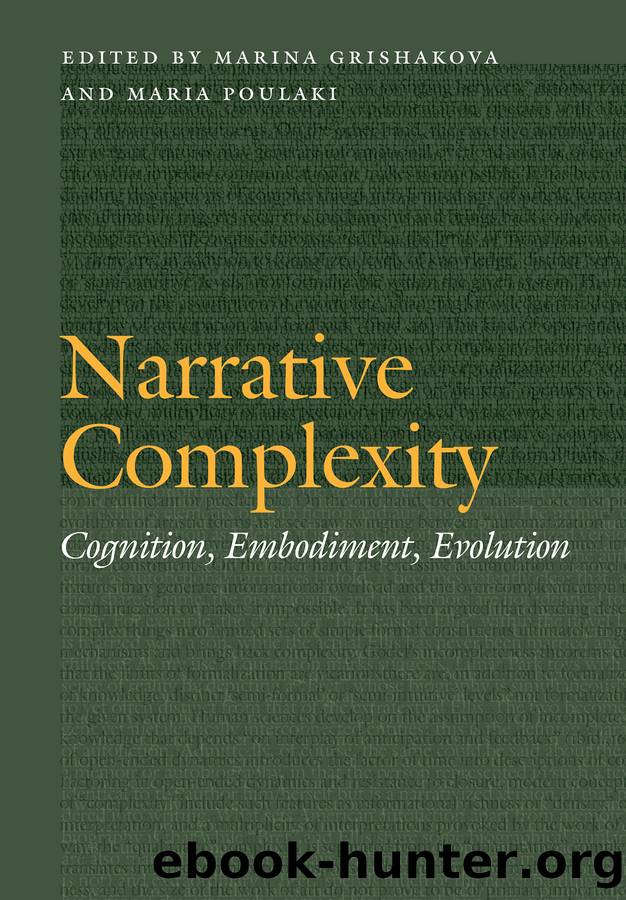Narrative Complexity by Unknown

Author:Unknown
Language: eng
Format: epub
Tags: LIT006000 Literary Criticism / Semiotics & Theory, SOC052000 Social Science / Media Studies
Publisher: University of Nebraska Press
Microworlds: Complexity Reduction through Domain Specificity
Limiting language to specific domains, which presumably involve a closed subset of a given natural language, is one of the key avenues AI pursued in language research. The following are early examples of this approach.
STUDENT was a program developed to solve algebraic story problems such as this: if the number of customers Tom gets is twice the square of 20 percent of the number of advertisements he runs, and the number of advertisements he runs is 45, what is the number of customers Tom gets? (Bobrow 1964).To solve this problem, STUDENT looked for cues such as ânumber,â âtwice,â âsquare,â and so on to break the sentence into chunks, assigned variables to these chunks, formed equations, and solved them. A typical stumbling block of its approach to language was that it interpreted the phrase âthe number of times I went to the moviesâ as the product of the two variables âthe number ofâ and âI went to the moviesâ (Russell and Norvig 1995, 11).
SHRDLU was a simulation of a robotic hand that moved colored blocks around in a virtual world shown on a monitor, following instructions given to it in natural language. It could precisely follow instructions as complicated as âFind a block which is taller than the one you are holding and put it into the boxâ or âMove the red cube to the left of the big block to the boxâ (Winograd 1972, 66). A simulated robot built at MIT, which operated in a simulated-blocks microworld, SHRDLU was equipped with a graphic interface and a video screen that displayed its operations in a visual manner. Furthermore, it had a written-language interface through which it not only followed commands given in ordinary English but also answered questions about its âmotivationsâ for doing things in a certain sequence. When asked why it picked up the little pyramid among its blocks, for instance, it replied, âto clear off the red cube.â Moreover, it was also able to remember and report its previous actions, such as touching a particular pyramid before putting a particular block on a particular small cube (Crevier 1993). With these capabilities, SHRDLU boasted as an impressive system in its time. For all its linguistic virtuosity, though, SHRDLU was very brittle and was rigidly restricted to the blocks domain.
Download
This site does not store any files on its server. We only index and link to content provided by other sites. Please contact the content providers to delete copyright contents if any and email us, we'll remove relevant links or contents immediately.
The Japanese by Christopher Harding(1070)
Watercolor With Me in the Forest by Dana Fox(743)
A Theory of Narrative Drawing by Simon Grennan(738)
The Story of the Scrolls by The Story of the Scrolls; the M(720)
Glittering Images: A Journey Through Art From Egypt to Star Wars by Camille Paglia(699)
Boris Johnson by Tom Bower(615)
This Is Modern Art by Kevin Coval(588)
The Art and Science of Drawing by Brent Eviston(583)
Frida Kahlo by Frida Kahlo & Hayden Herrera(575)
AP Art History by John B. Nici(566)
Banksy by Will Ellsworth-Jones(562)
War Paint by Woodhead Lindy(542)
Van Gogh by Gregory White Smith(539)
Draw More Furries by Jared Hodges(535)
Scenes From a Revolution by Mark Harris(534)
About Looking by John Berger(530)
Ecstasy by Eisner.;(526)
100 Greatest Country Artists by Hal Leonard Corp(515)
Young Rembrandt: A Biography by Onno Blom(505)
